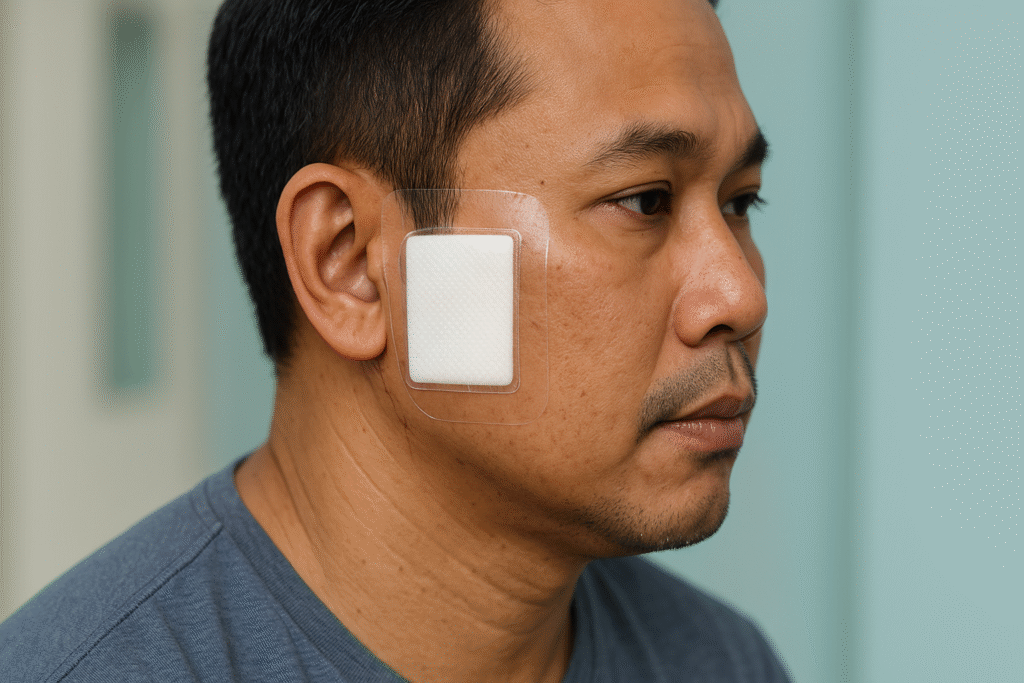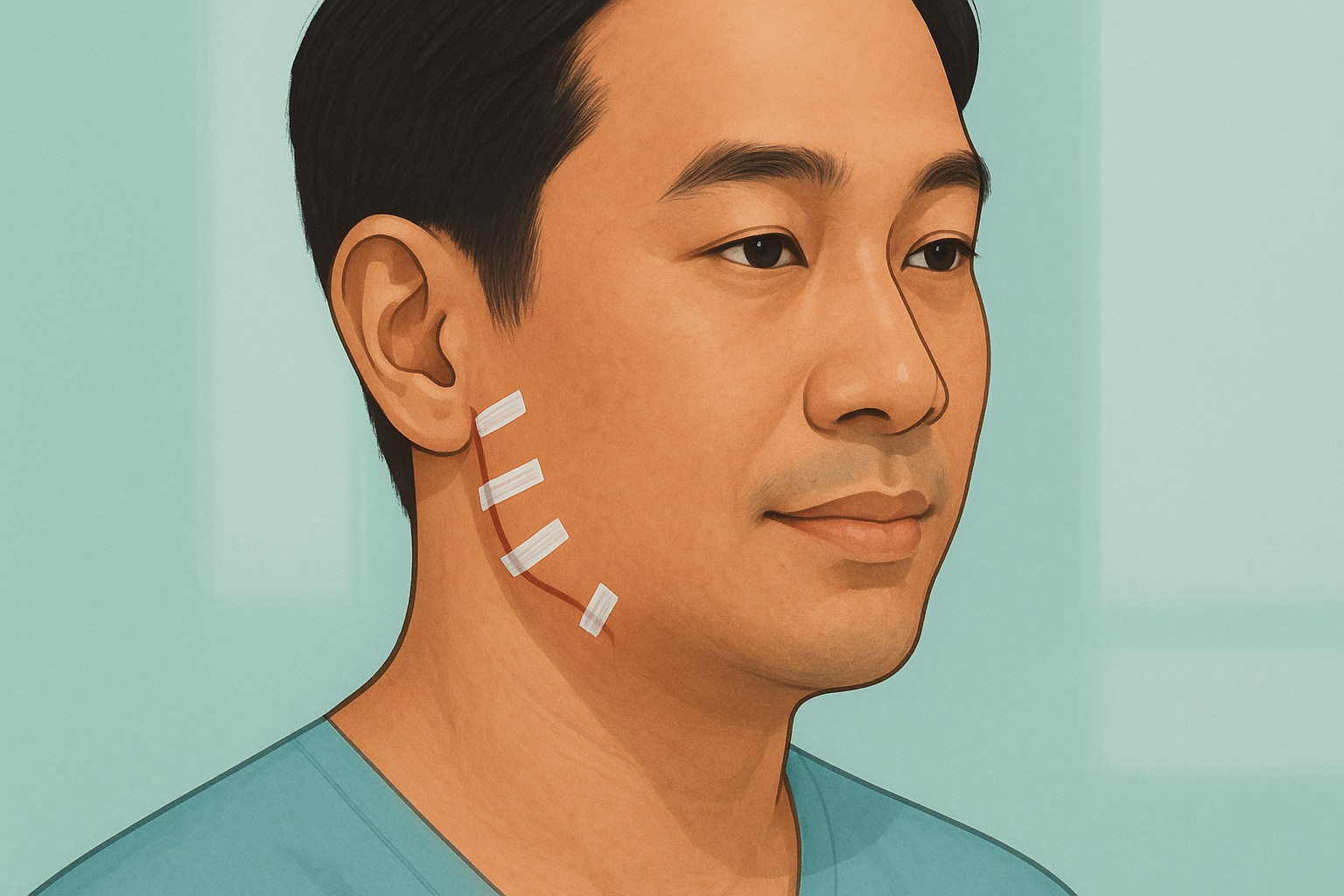What you can expect after surgery
- A curved incision usually runs in front of the ear and into the upper neck. Mild swelling, bruising and a feeling of tightness are normal in the first week.
- A small drain is commonly placed and removed within 1–2 days once fluid output is low; some hospitals keep it longer if needed. Aneurin Bevan University Health Board
- Your dressing is typically kept on and left undisturbed for the first 48 hours unless it’s leaking; this is consistent with international surgical site infection guidance. World Health OrganizationNCBI
Always follow the specific instructions from your own surgical team—if they differ from what’s written here, their advice comes first.

Days 0–2: Protect and rest
- Keep the dressing clean, dry, and intact for at least 48 hours. Avoid touching the wound. World Health OrganizationNCBI
- Sleep with your head slightly elevated (extra pillow) to reduce swelling.
- Ice packs are generally not needed on the parotid area; if used, keep wrapped and limit to 10 minutes to avoid skin injury.
- Take pain medication as prescribed (for many, paracetamol is enough). Avoid non-prescribed blood-thinners unless your doctor says otherwise.
From 48 hours: Showering and basic cleaning
- Showering is usually safe after 48 hours unless your surgeon advises longer; let water run gently over the area—do not rub. Pat dry with a clean towel. nhs.ukCambridge University Hospitals
- If you still have a dressing, check whether it’s waterproof; many can stay on in the shower. Replace any wet dressing with a clean, dry one. Cambridge University Hospitals
- Do not soak the wound (no baths, swimming) until fully healed. nhs.uk
- Skip harsh agents like hydrogen peroxide or iodine on the incision—they can slow healing. Use mild soap and water only if instructed. MyHealth Alberta
Malaysia tip: our weather is hot and humid—sweat can macerate (soften) the wound. Choose loose, breathable clothing and gently blot moisture around the incision during the day.
Dressings, stitches and staples
- If you left hospital with Steri-Strips™ or a simple dressing, your team will advise when to remove/replace them.
- Stitches on the face/neck are commonly removed around day 5–7 (if not dissolvable). Never remove them yourself—have a nurse/clinic do it. northerncarealliance.nhs.uk
- Some hospitals ask you to keep the initial dressing longer (up to a week) based on the exact operation—follow that plan. WSH NHS
Drains: what’s normal
- A soft tube may exit behind/near the ear and is attached to a small bottle. It usually comes out in 24–48 hours once drainage is minimal. If you go home with it, your team will show you how to keep it upright and record the output. Aneurin Bevan University Health Board
Swelling, saliva leaks and other common issues
- Sialocele (saliva collection): a soft, fluctuating swelling near the wound that may appear days after surgery. Most settle with needle aspiration and a pressure dressing; anticholinergic medication or botulinum toxin may be used if persistent. PMC+1
- Routine pressure dressings for everyone aren’t clearly beneficial; recent research shows no significant advantage over standard dressings, so your surgeon may not use them. PubMed
- Frey’s syndrome (flushing/sweating while eating) can appear weeks to months later—annoying but manageable; we’ll review if it happens. Oxford University Hospitals
Scar care (after the skin is fully closed)
- Once the wound is fully closed and scabs are off (often after ~2 weeks), you may start gentle scar massage with a bland moisturiser or silicone gel if recommended.
- Protect the scar from sun with SPF 30+ and a hat for several months to minimise darkening—very relevant in our tropical climate.
Activity, diet and work
- Light walking from day 1 is encouraged. Avoid heavy lifting, strenuous exercise, and contact sports for ~2 weeks (or until cleared). University Hospitals Sussex
- Eat soft foods for a few days if chewing is uncomfortable.
- Many patients return to desk work after about a week; longer if your job is physical. Cambridge University HospitalsHull Teaching Hospitals
Red flags: when to see an ENT urgently
Seek medical attention immediately if you notice:
- Fever ≥38 °C, or feeling unwell with chills.
- Worsening redness, heat, increasing pain, or pus-like discharge from the incision.
- Rapidly increasing swelling or a tense, painful lump (possible haematoma). Royal Devon NHS
- Continuous clear/sticky fluid leaking from the wound or new soft swelling (possible sialocele). Royal Devon NHS
- New or worsening facial weakness (drooping, inability to close eye or smile).
- Persistent bleeding that soaks through the dressing.
For general wound-care principles used in Malaysian public hospitals, you can also refer to the MOH Wound Care Manual and Quick Reference. Ministry of Health MalaysiaQhub
Your first 2-week checklist
- Day 0–2: keep dressing dry and untouched; head elevated. World Health Organization
- From 48 h: shower (unless advised otherwise), pat dry, no scrubbing/soaking. nhs.uk
- Day 5–7: clinic review and likely suture removal if non-dissolving. northerncarealliance.nhs.uk
- By 2 weeks: consider scar care once fully closed; gradual return to normal exercise if the wound looks good and your surgeon agrees.
References & good reads
- WHO Global Guidelines for the Prevention of Surgical Site Infection (2018 update) — postoperative dressing advice. World Health Organization
- NCBI Bookshelf summary of WHO SSI guidance — keep dressings undisturbed for ≥48 h unless leaking. NCBI
- Cambridge University Hospitals (NHS): Caring for your surgical wound — practical showering tips after 48 h. Cambridge University Hospitals
- NHS: Recovery after surgery — general timelines for washing and activity. nhs.uk
- Aneurin Bevan UHB (NHS): Discharge advice after superficial parotidectomy — drains, what to expect. Aneurin Bevan University Health Board
- Royal Devon (NHS): Parotidectomy patient leaflet — haematoma and saliva leak information. Royal Devon NHS
- PubMed 2024: Pressure dressings after parotidectomy show no significant benefit — why your surgeon may skip routine pressure. PubMed
- MOH Malaysia: Wound Care Manual & Quick Reference — local principles used across Malaysian hospitals. Ministry of Health MalaysiaQhub
When to see an ENT
- You’re worried about swelling, leakage, or increasing redness around the incision.
- You develop facial weakness, eye irritation (can’t close the eye), or severe pain.
- The wound opens, bleeds repeatedly, or there’s persistent fluid collection.
- Any fever ≥38 °C or feeling unwell after the first 48 hours.
If you’re in the Klang Valley and need a review, my clinic team can arrange a prompt wound check and stitch removal—just reach out.
Related reading (internal links)
- Facial Nerve Weakness After Parotid Surgery: What’s Normal? (
/blog/facial-nerve-weakness-after-parotidectomy) - Frey’s Syndrome: Why My Cheek Sweats When I Eat (
/blog/freys-syndrome-malaysia) - Saliva Leaks (Sialocele) After Parotidectomy—Treatment Options (
/blog/sialocele-after-parotidectomy) - Understanding Salivary Gland Tumours (
/blog/salivary-gland-tumours-guide)
A gentle reminder
Everyone heals a little differently. If anything doesn’t look or feel right, don’t wait—contact your surgical team or see an ENT. For personalised advice after parotid surgery in Malaysia, you’re welcome to book an appointment with me.


Comments are closed